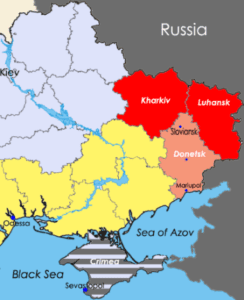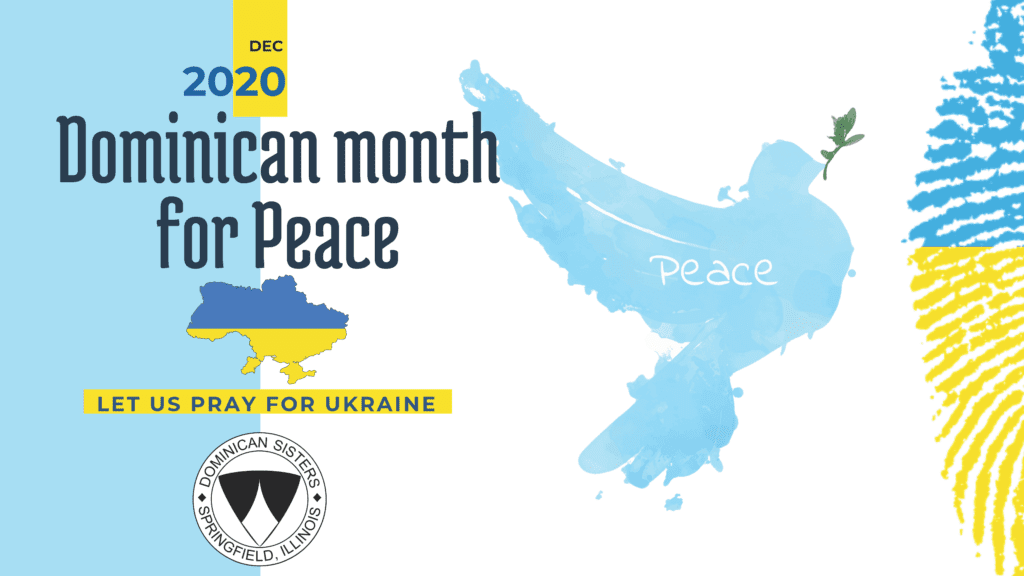Week 1 focused on introducing the Dominican history in Ukraine.
Week 2 focused on Dominican efforts to help young persons to heal and learn peace building skills, skills that will positively impact Ukraine’s future.
Week 3 focused on specific efforts to facilitate peace building efforts through leadership training and promoting reconciliation in local communities and among the military.
This week will focus on current, international peace-building efforts. These efforts are part of a larger effort in the European community to bring peace.
International Peace Conference
In 2018 – 2019, an international conference took place in France and Ukraine consisting of 4 seminars focused on “What peace plan is possible between Russia and Ukraine?” The main purpose of the conference was to explore ways of overcoming tensions between Ukraine and Russia and to understand how interstate and intercultural ties between the two countries could be further developed.

Scientists, academics, religious, and public figures from Ukraine, Russia and the European Union participated in it at various stages. It was the first time that the leaders of the two countries had met.
Representatives of the Dominicans participated in the conference as part of the Ukrainian delegation. The Dominican Institute of Religious Sciences of St. Thomas Aquinas in Kiev hosted one of the seminars of the conference.
While not successful in stopping the war, some prisoners of war were exchanged. Though eight ceasefires have been negotiated, most have not held. The most recent one of July 27, 2020 has been thus far the most effective but not complete.
Russia's Claws in Ukraine: Highlights from Webinar
A webinar sponsored by the North American Promoters of Justice and Peace and Care of Creation, recorded December 19, 2020.
Featuring:
- Archbishop Borys Gudziak, Ukrainian Catholic Archeparchy of Philadelphia, USA and President of Ukrainian Catholic University (Lviv) On a background history and on the experience of Ukrainian Catholic Church in the USA and in Ukraine.
- Nataliya Popovych, Deputy Chair of the Board, Co-founder, Ukraine Crisis Media Center, and Senator at Ukrainian Catholic University (Lviv) On the NGO’s and civil society and the current war in Donbas Region and Russian illegal occupation of Crimea.
- Andrej Lushnyky, Executive Director, American College Program, University of Fribourg (CH), and Honorary Consul of Ukraine in Switzerland On recent struggles of Ukraine and co-founding of Ukrainian Forum at Swiss Parliament.
- Andrew Tkach, Independent Media Producer Sharing some of his documentary work on the crisis in Ukraine
A signature quality of the Ukrainian people is their resiliency. They survived Stalin’s man-made famine in 1932-33, an example of using food as a weapon of mass destruction. Citizens lived in the same place and changed nationality six times in 40 years. There was a constant cycle of invasion and taking-over by other countries or empires.
As big as Texas, Ukraine is geographically bigger than any country solely in Europe. It has a population of 40 million. The geographic center of Europe resides in western Ukraine in the Carpathian Mountains.
In its 1000-year history, the Church has been the one consistent institution throughout the history of the people. There was a disruption under Soviet control when the church was suppressed and forced to go underground. 10% of the clergy survived to go underground to serve the 1% of population that held on to faith and liturgy – at risk of death. Once the people declared independence in 1991, Ukraine’s leaving was the last nail in the Soviet coffin.
The surviving church carried moral authority as it was the only institution that hadn’t collaborated with the Soviets. That legacy of maintaining a social doctrine, a philosophy of how people should live together justly, was carried into the experience of independent Ukraine.
In 2013, the people wanted to join the European Union; the Ukrainian president was opposed and wanted closer ties to Russia. That started the protests in 2013 throughout the winter. People, close to 5000, camped in the square (maidan) for 2 ½ months supported by Ukrainians from all classes, all language speakers, all professions. Food, housing, art, and music were shared freely.
ALL of Ukraine’s religious communities came together with the people in solidarity, literally standing for a few basic principles:
- People have a right to express their opinion
- No violence should be used by anyone
- Any language dividing the country is immoral
- Dialogue is the only way forward
What started out as Euromaidan became a Maidan of Dignity, a movement focused on the inalienable dignity of every human being. It was a laboratory for a different kind of society -- against corruption, for freedom of the press, and for dignity of the human person.
The solidarity of the movement was strong enough to unseat the former president. Putin’s fear that the strength of this movement would move into Russia, led to
Russia moving troops into eastern Ukraine and annexing Crimea. It is not a war for territory or to support Russian speaking Ukrainians. It is a war to suppress the democratic movement that was being articulated by the Ukrainian people in 2013.
The unrest and conflict in Ukraine is a metaphor for the rest of the world. The global community has parallel stories of the tactics being used: control of media, terror, intentional spread of lies and disinformation to confuse the people and make them distrust one another.
It is essential that we continue our prayer, study, and solidarity so that we can join with others to be a force that moves peace efforts forward.
For a powerful perspective on the challenges facing this corner of eastern Europe for a century, you might, for a very small fee, rent the online video Hunger for Truth by Andre Tkach. https://vimeo.com/ondemand/hungerfortruth
Suggested intercessory prayer for week 4 (for Eucharist, Morning and Evening Prayer, Private Prayer)
For continued resilience of the Ukrainian people and an end to the fighting. For the ongoing work of the Dominican Family to facilitate reconciliation, promote healing, and engage in dialogue with other peace-builders.


